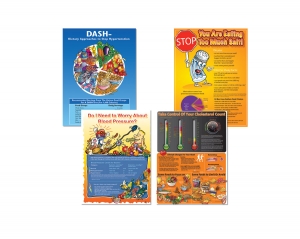It’s different when it happens to you.
I’ve been teaching fitness and wellness topics for many years. I’ve taught heart-healthy cooking, strong bone nutrition, dining with diabetes, and lots of general healthful eating strategies. I’ve seen people get frustrated as they try to understand conflicting dietary recommendations. I’ve seen people struggle to make major lifestyle changes as a result of a medical diagnosis. Nothing seems to make people more serious about a dietary change than a sudden health event. But nothing you can teach makes this more real than when it’s your family.
Last September, when I was on my way home from a conference, I got a phone call. My husband had had a heart attack.
He survived.
We were lucky. Statistics show that 1 in 4 deaths in the United States are a result of heart disease. After four nights in the hospital, three ambulance rides, two stents, and one drug reaction, my husband was finally released from the hospital. Ultimately, we were sent home with little fanfare. There were some packets and informational materials, but that was it. We were on our own.
Included in the pile of computer printout packets were four pages titled “Cardiac Diet.” Now, I have been teaching this topic for years, so I didn’t feel like I was completely unknowledgeable. But I was sure that there was more to this. Maybe there was something I missed in all the classes I’ve taken. After all, this wasn’t just “reducing risk factors” and other classroom subjects. This was the real thing. My husband had had a heart attack.
I was hoping that a registered dietitian could tell me more. I wanted specifics. I wanted calories, grams, and milligrams. I wanted more than a list of foods that were “allowed” and other foods to “avoid.” You can’t eat like that, I thought. So, I asked if we could talk with a dietitian.
Unfortunately, because we live in a small rural community, there was no dietitian on staff for that.
Suddenly, I’m looking at this from the inside out. I’m not blaming the hospital, the doctors, or the nurses; they have enough on their plate already. But, I don’t think I’m an exception to the rule. I think that there are lots of folks out there who want more than a piece of paper and they want a step by step lesson for what to do. If you think about what you teach in this manner you can make more effective materials.
Thank goodness for those of you who do have the time to teach cooking, do consultations, and offer classes on cardiac rehabilitation diets. Please keep up the good work. I’m joining the charge. In fact, I’m currently looking for a grant so that I can teach some heart-healthy cooking classes in my community.
So now it’s real. My husband and I are learning a lot about heart disease, and I’m looking at it from an entirely different perspective. Here are some very helpful cooking handouts that can help folks make healthier foods. And here is a free handout for an overview of a heart healthy diet: EatRightHeart
More tips to come!
By Cheryle Jones Syracuse, MS
Professor Emeritus, The Ohio State University
From the Nutrition Education Store Staff:
You don’t have to create all the materials to communicate key heart health messages by yourself. Let us do it for you! Here are some of the most popular heart health educational materials…


